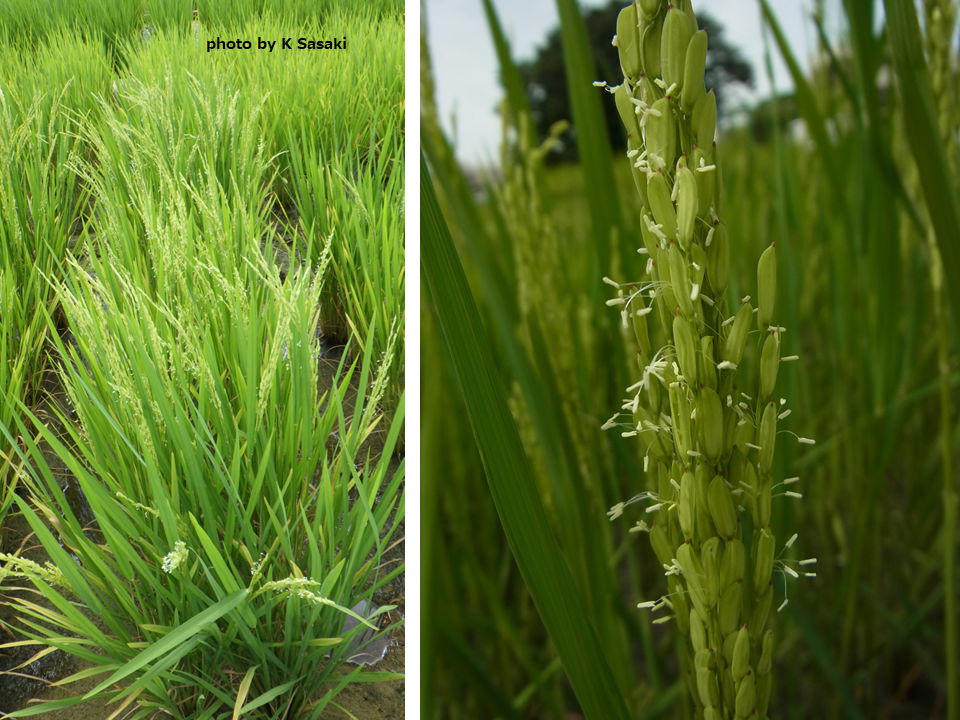Pick Up
572. Using Rice Early-Morning Flowering Trait to Reduce Sterility Due to High Temperature

Is this a super hot year? It is indeed extremely hot! In central Tokyo, a maximum temperature of 35.4°C was recorded on June 25, which seems to have been the earliest extremely hot day since 1875 (Meiji 8), when records were kept. Such high temperatures have an impact on rice production. It is known that rice is most sensitive to high temperatures during flowering, and that even one hour of exposure to temperatures of 35°C or higher will cause sterility (empty grains) due to lack of fertilization. In 2018, when record high temperatures were recorded over a wide area, sterility was reported to have occurred at a higher rate than usual (NARO Press release). The risk of occurrence of sterility due to high temperatures is also increasing in tropical regions. Based on the unique idea of making flowers bloom early in the morning when it is cooler to avoid high temperatures during flowering, JIRCAS is conducting research on early-morning flowering (EMF), which makes this possible.
We have bred a line (IR64 +qEMF3) with early-morning flowering trait to an indica variety (IR64) that is widely used in tropical regions (Research Highlights). In fact, we found that IR64 +qEMF3 flowered more than one hour earlier in high-temperature regions of Myanmar, and the occurrence of high temperature-induced sterility was kept low. The results showed that IR64 +qEMF3 was able to maintain a high fertility rate when the maximum daytime temperature was 36°C or higher, which contributed to a stable yield. These results represent the first field-level study to demonstrate that early-morning flowering trait contributes to rice productivity in hot regions (Ishimaru et al. 2022a).
In addition, changes in precipitation due to climate change are predicted in the future, and it is important to ensure crop production under drought stress conditions due to water scarcity. In drought-stressed plots, plant transpiration is restricted and panicle temperature increases; IR64 +qEMF3 was able to flower in the early-morning hours even in drought-stressed plots and kept panicle temperature significantly lower than IR64. Some of the drought stress tolerant rice lines bred at the International Rice Research Institute (IRRI) were susceptible to high temperatures, indicating that early-morning flowering potential could complement drought stress tolerant breeding efforts (Ishimaru et al. 2022b).
The use of early-morning flowering trait is expected to promote the development of rice varieties that reduce high temperature-induced sterility.
References
NARO Press Release: Heat-induced sterility of rice observed in paddy fields in Japan in an extremely hot summer https://www.naro.go.jp/english/laboratory/niaes/press/hiss/index.html
JIRCAS Research Highlights:Development of a near-isogenic line with early-morning flowering trait in the genetic background of Indica-type variety in the tropics
https://www.jircas.go.jp/en/publication/research_results/2014_a02
Ishimaru, T., Hlaing, K. T., Oo, Y. M., Lwin, T. M., Sasaki, K., Lumanglas, P. D., ... & Htun, T. M. (2022a). An early-morning flowering trait in rice can enhance grain yield under heat stress field conditions at flowering stage. Field Crops Research, 277, 108400. https://doi.org/10.1016/j.fcr.2021.108400
Ishimaru, T., Sasaki, K., Lumanglas, P. D., Carlo, L. U. C., Ye, C., Yoshimoto, M., ... & Henry, A. (2022b). Effect of drought stress on flowering characteristics in rice (Oryza sativa L.): A study using genotypes contrasting in drought tolerance and flower opening time. Plant Production Science. https://doi.org/10.1080/1343943X.2022.2085589
Pick up articles on high temperatures
488. Mismatch in Seasons and Life Cycle Patterns of Plants and Animals Due to Climate Change
255. Changes in Four Seasons Due to Global Warming
147. Asymmetric changes on the impact of climate change during daytime and night-time
Contributor: SASAKI Kazuhiro (Biological Resources and Post-harvest Division)
